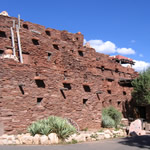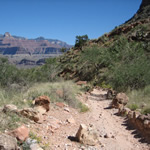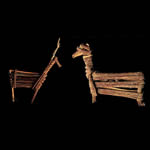 The Travelin’ Trunk team fashioned an entirely new trunk—a mini-archive in a box—for middleand high school classrooms on Grand Canyon’s human history, and they created additional lessons that are available below.The curriculum serves as a window onto American history and as a microcosm for learning about human encounters with the land and other peoples. Lessons explore important themes and eras emphasized on the project’s website and aligned with state and national educational standards such as the role of the federal government, progressivism, and civil rights.
The Travelin’ Trunk team fashioned an entirely new trunk—a mini-archive in a box—for middleand high school classrooms on Grand Canyon’s human history, and they created additional lessons that are available below.The curriculum serves as a window onto American history and as a microcosm for learning about human encounters with the land and other peoples. Lessons explore important themes and eras emphasized on the project’s website and aligned with state and national educational standards such as the role of the federal government, progressivism, and civil rights.
Moreover, the trunks help engage students in doing history by reading and analyzing primary documents, offering interpretations, and examining life at the canyon over time. They focus on important concepts—use, movement, and power—by asking students to think about who used the canyon, how it was used, and why. They ask students to ponder who visited and who stayed at the canyon. In addition to essential questions of use and movement, lessons involve students in thinking about power relations at the canyon. Who claimed rights to the area? Does anyone own the place? Who decides?
You may download the PDF of the teacher guide here.
Educators may borrow the Travelin’ Trunks for a two-week period to help their students learn about the Grand Canyon. For more information on ordering a trunk, visit the Grand Canyon Association’s website at http://www.grandcanyon.org/fieldinstitute/educators_trunk.asp
In addition to the secondary Travelin’ Trunk, the team created lessons that can be accessed from the links below. It’s our hope that these lessons offer some concrete strategies for enlarging the classroom and making history meaningful by connecting local history to national and international themes.
 Photo: Patricia Biggs
Photo: Patricia Biggs Art of Grand Canyon
These lessons explore the dynamic relationship between art and society and how artists seek to influence society through their craft. After working through these lessons students will be able to identify and note the...
 Photo: Yolonda Youngs
Photo: Yolonda Youngs Damming Controversy
The Grand Canyon region has existed and continues to exist amid controversy. People have contested boundaries and debated ways to utilize the space. Some uses provide human benefits but threaten the sustainability of this...
 Photo: NPS
Photo: NPS Indian New Deal
In 1933 John Collier was appointed commissioner of Indian Affairs. He initiated a number of reforms that became known as the Indian New Deal. As Americans we can learn how federal policies can impact...
 Photo: Yolonda Youngs
Photo: Yolonda Youngs Map and Art
Maps provide a sense of scale and perspective, and topographical maps, in particular, help us understand the natural and cultural contours of a place. Through this lesson students will be able to understand the...
 Photo: Patricia Biggs
Photo: Patricia Biggs New Deal
This lesson explores the work of the Civilian Conservation Corps at Grand Canyon during the years of the Great Depression. Students explore the role of government during a period economic decline, wrestling with the...
 Photo: Bill Hatcher.
Photo: Bill Hatcher. Progressive Era
Progressive movement activists pushed for and achieved the establishment of Grand Canyon as a National Park. In this lesson students will analyze the legislative acts that created the national park system, make connections between...
 Photo: AP Digital Photo Archive
Photo: AP Digital Photo Archive Civil Rights Era
Havasupai Empowerment and Land Restoration Since the 1880s when the Havasupai were first forced onto a reservation of 518 acres until 1975 when their acreage was expanded, has life for the Havasupai remained the...
 Photo: NAU, Cline Library
Photo: NAU, Cline Library Sustainability
Water is one of the most, if not the most, vital resources in the American West. In this lesson students will analyze water issues at Grand Canyon. Students will then make connections between water...
